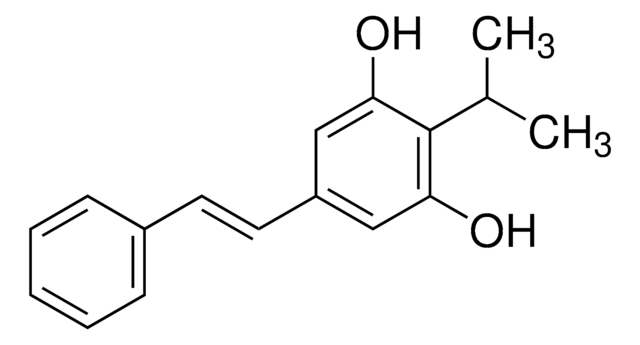48599
2,3,7,8-Tetrachlorodibenzo-p-dioxin solution
analytical standard
Sinónimos:
2,3,7,8-TCDD
Iniciar sesiónpara Ver la Fijación de precios por contrato y de la organización
About This Item
Productos recomendados
grade
analytical standard
CofA
current certificate can be downloaded
packaging
ampule of 1 mL
storage temp.
2-8°C
InChI
1S/C12H4Cl4O2/c13-5-1-9-10(2-6(5)14)18-12-4-8(16)7(15)3-11(12)17-9/h1-4H
InChI key
HGUFODBRKLSHSI-UHFFFAOYSA-N
General description
2,3,7,8-Tetrachlorodibenzo-p-dioxin is a highly distributed environmental contaminant, released by industrial activities, which can act like as a reproductive toxicant and endocrine disruptor in all vertebrates.
2,3,7,8-Tetrachlorodibenzo-p-dioxin is the most potent congener of dioxins and dioxin-like chemicals, which can exert adverse effects in laboratory animals used in testing.
Application
2,3,7,8-Tetrachlorodibenzo-p-dioxin solution has been used as standard in investigating the effect of 2,3,7,8-Tetrachlorodibenzo-p-dioxin to offsprings of fish, using high performance gas chromatography coupled with high performance mass spectrometry (HPGC-HPMS).
Refer to the product′s Certificate of Analysis for more information on a suitable instrument technique. Contact Technical Service for further support.
signalword
Danger
Hazard Classifications
Aquatic Chronic 1 - Asp. Tox. 1 - Flam. Liq. 2 - Repr. 2 - Skin Irrit. 2 - STOT RE 2 - STOT SE 3
target_organs
Central nervous system
Storage Class
3 - Flammable liquids
wgk_germany
WGK 3
flash_point_f
39.2 °F - closed cup
flash_point_c
4 °C - closed cup
Elija entre una de las versiones más recientes:
¿Ya tiene este producto?
Encuentre la documentación para los productos que ha comprado recientemente en la Biblioteca de documentos.
K A Solak et al.
Toxicology, 311(3), 124-134 (2013-07-23)
The aryl hydrocarbon receptor (AhR) is involved in a wide variety of biological and toxicological responses, including neuroendocrine signaling. Due to the complexity of neuroendocrine pathways in e.g. the hypothalamus and pituitary, there are limited in vitro models available despite
E C Rada et al.
Chemosphere, 110, 53-61 (2014-06-02)
Atmospheric depositions of polychlorinated dibenzo-p-dioxins and dibenzofurans (PCDD/Fs) and polychlorinated biphenyls (PCBs) were monitored at three sites in the vicinity of a steel making plant, located in an Italian alpine valley. A high variability in the deposition of PCDD/Fs was
Filomena Fiorito et al.
Toxicology, 290(2-3), 258-270 (2011-10-22)
The administration of 2,3,7,8-tetrachlorodibenzo-p-dioxin (TCDD) to a variety of cultured cells may alter their ability to proliferate and die. In a previous study we demonstrated that TCDD induced proliferation in Madin-Darby Bovine Kidney (MDBK) cells where no signs of apoptosis
Maria Herlin et al.
Toxicology and applied pharmacology, 273(1), 219-226 (2013-09-17)
Bone is a target for high affinity aryl hydrocarbon receptor (AHR) ligands, such as dioxins. Although bone morphology, mineral density and strength are sensitive endpoints of dioxin toxicity, less is known about effects on bone microarchitecture and material properties. This
Tomoki Takeda et al.
Molecular pharmacology, 85(1), 74-82 (2013-10-18)
Our previous studies have shown that treatment of pregnant rats with 2,3,7,8-tetrachlorodibenzo-p-dioxin (TCDD; 1 μg/kg) at gestational day (GD) 15 reduces the pituitary synthesis of luteinizing hormone (LH) during the late fetal and early postnatal period, leading to the imprinting
Nuestro equipo de científicos tiene experiencia en todas las áreas de investigación: Ciencias de la vida, Ciencia de los materiales, Síntesis química, Cromatografía, Analítica y muchas otras.
Póngase en contacto con el Servicio técnico

![Benzo[a]pyrene ≥96% (HPLC)](/deepweb/assets/sigmaaldrich/product/structures/253/820/be96d879-1811-46c0-8f11-612019691c2d/640/be96d879-1811-46c0-8f11-612019691c2d.png)









